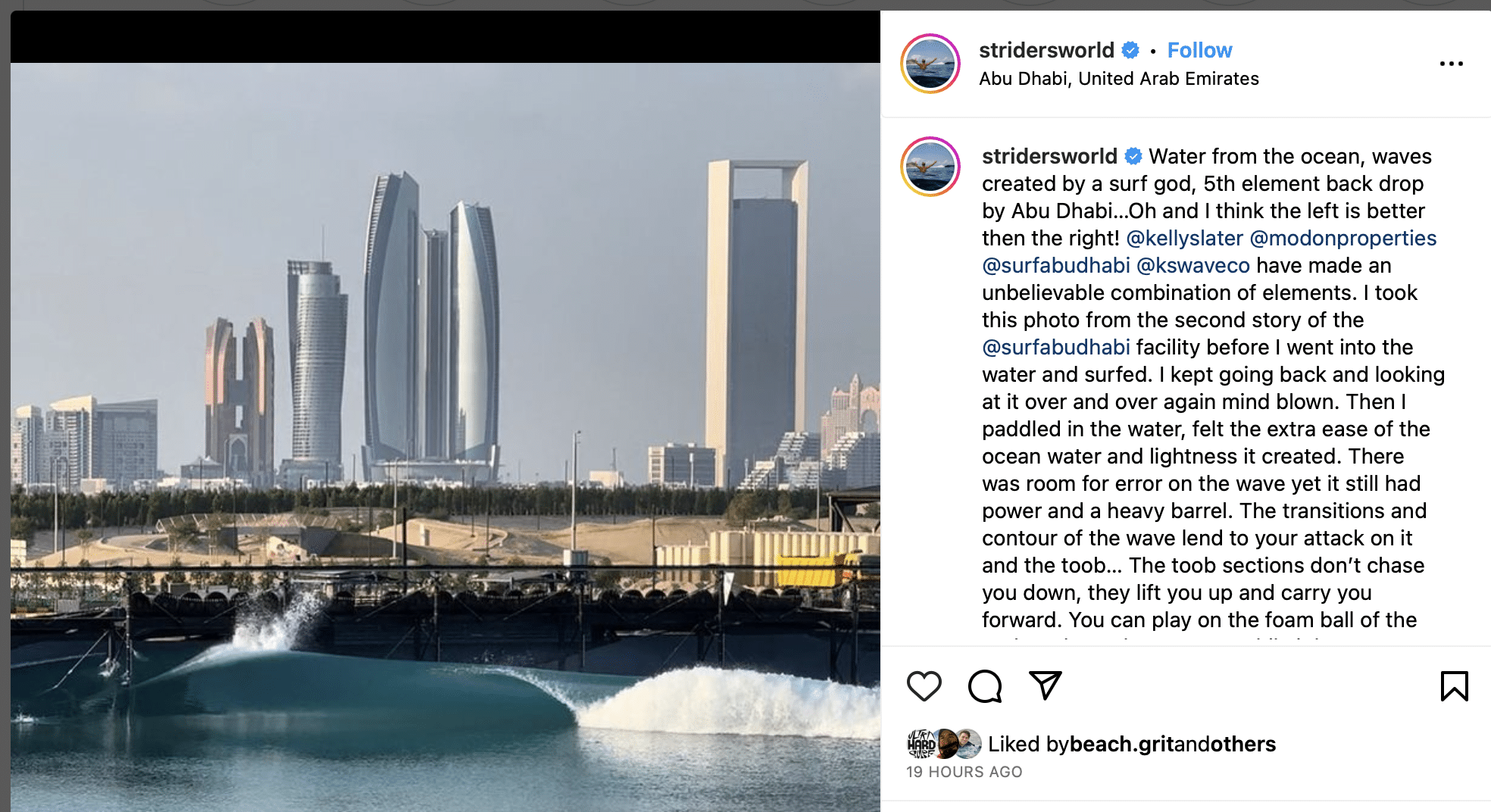“I could see a scenario where we may see up to 20X more surfers catching waves with the same amount of energy compared to Lemoore.”
The Kelly Slater wave pool in Abu Dhabi has attracted much fanfare over the past three days, tears from the progressives, excitement from surfers who’d die for a little slice of that warm-water Persian Gulf magic.
Strider Wasilewski, whose protuberant nipples has made him a surfing pinup, described the joy of surfing the perfect Kelly Slater wave blooming from the desert sands.
“The transitions and contour of the wave lend to your attack on it and the toob… The toob sections don’t chase you down, they lift you up and carry you forward. You can play on the foam ball of the toob and your heart races while it happens.”

A common refrain among surf fans, however, was disappointment that the Kelly Slater wave didn’t appear any different to the prototype in Lemoore, California.
Oh, but they are so wrong.
An online sleuth from New Jersey, Gil Olson, has put paid to that notion with an extensive comparison of the two tanks using Google Maps and published on LinkedIn in July.
And the difference between the two Kelly Slater pools?
Well, first, it’s almost twice as wide (450 feet compared to 250), although the foil mechanism, which pushes the water to make the wave, is roughly the same.
The groundbreaking diff is the bathymetry of the two Kelly Slater pools.
Writes Olson,
The most noticeable upgrade (from satellite images, at least) is the “W” shaped features in the lagoon.No sane person knocks the quality of the waves at The Surf Ranch. The “achilles heel” for KSWC’s technology system has been the rate of wave generation.
In Lemoore, the system generates a 1-minute wave after ~4 minutes of settling, or about 12-13 foil runs (full pool length waves) per hour. It looks to me like The Oasis will significantly improve these metrics through innovative engineering that produces secondary, and possibly even tertiary, rideable waves on the “W” Reef Formation.
At The Oasis, it looks like the primary wave will traverse the entire length of the pool and break before the excess energy reforms on the “W” shaped reef. The three arms of the “W” could produce waves of different intensities and heights, accommodating surfers of varying skill levels. I could see a scenario where we may see up to 20X more surfers catching waves with the same amount of energy compared to the Lemoore Ranch.
Decoding the ‘W’
The most obvious feature of The Oasis, even from satellite images, is the “W” shaped structure in the lagoon. In Lemoore, a single, minute-long primary wave is produced every four minutes. I’m betting on a dramatic improvement to ridable wave count, thanks to some ingenious engineering.
Maximizing Wave Count with better Energy Utilization
Dr. Fincham and friends have seemingly devised a method to harness residual energy, creating secondary, and potentially even tertiary, rideable waves along the “W” Reef Formation. This suggests more surfable waves per foil pull (ie. the same energy expense) and a faster wave frequency. My prediction? The turnaround time could drop to about 2 minutes, possibly even less.
How?
The new design seems to suggest a more efficient use of energy. It appears the primary wave (“1” in Fig. 2) will traverse the pool’s length, and then lots of that excess energy reforms on the “W” shaped reef to create more ridable waves on each foil run.
Very clever, yes?





